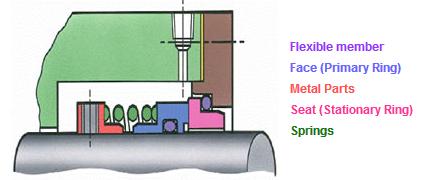Main structure of the mechanical seals
Main structure of the mechanical seals
 The mechanical seasl shown in above is a simple light-duty design. The sealing interface where the seal rotating and stationary faces make rotational contact is a plane annulus. The sealing faces themselves are lapped to a very high degree of flatness, measured in wavelengths of light. The body of the rotating component of the mechanical seal is free to float axially. This enables hydraulic pressure to keep the main sealing faces together in operation; in the absence of hydraulic pressure the spring serves the same purpose
The mechanical seasl shown in above is a simple light-duty design. The sealing interface where the seal rotating and stationary faces make rotational contact is a plane annulus. The sealing faces themselves are lapped to a very high degree of flatness, measured in wavelengths of light. The body of the rotating component of the mechanical seal is free to float axially. This enables hydraulic pressure to keep the main sealing faces together in operation; in the absence of hydraulic pressure the spring serves the same purpose
The closing force on the seal is designed to provide an acceptable compromise between leakage and wear. It must also be sufficient to prevent the faces from separating in the event of mechanical shock or a pressure fluctuation. A secondary seal prevents leakage between the floating assembly and the shaft; often a rubber `O' ring is used for this purpose.


